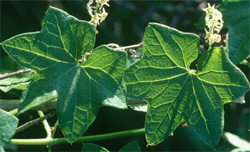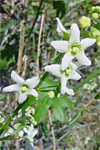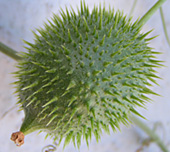

Slightly pointed, lobed leaves.

Male flowers
M. macrocarpus has leaves similar to M. horridus though they are more polygonal with more pointed apices. Stems are a slightly gray-green color. As would be expected from its arid habitat, M. macrocarpus stems and leaves are the most densely pubescent of the manroots.

Unripe fruit with whithered flower
M. macrocarpus flowers are small and usually white. The short-stemmed male flowers point out and upward from the bloomstem. Female flowers, like all marah species, hang from the base of the male bloomstem.
Fruit of M. macrocarpus tend to be oval to oblong, and are covered in flexible spikes that are slightly dispersed. M. macrocarpus can produce fruit as large as M. horridus in the right circumstances, but fruit are usually smaller with 4-8 smooth, bullet-like seeds.
Wikipedia Entry »Jepson Manual Treatment »
Calphotos Images »



